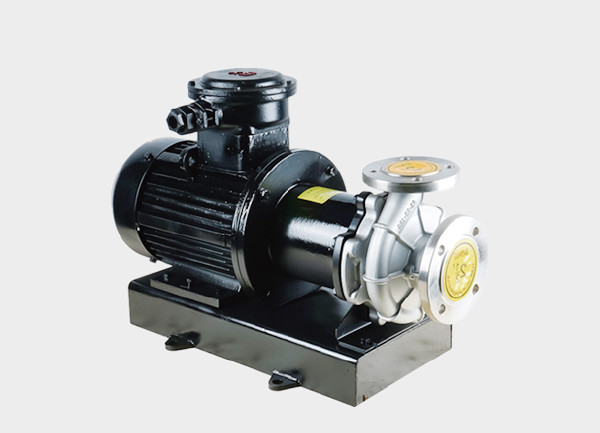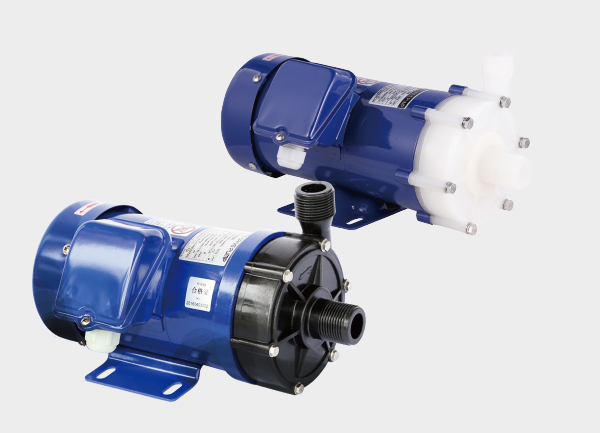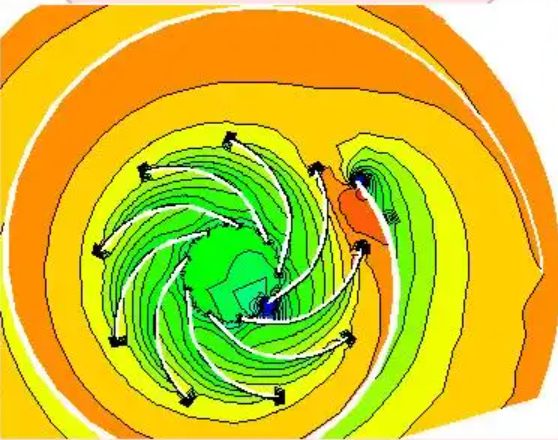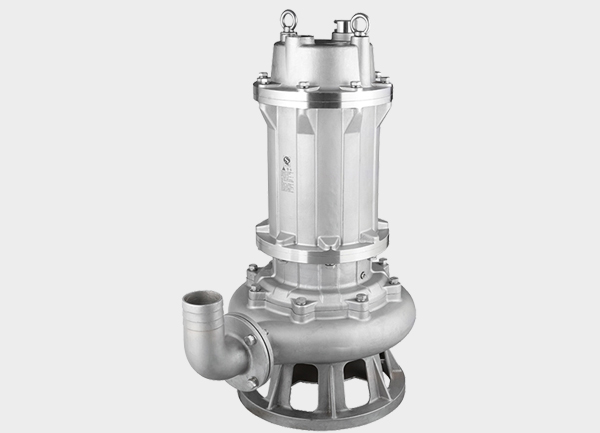High-pressure magnetic drive pumps (also known as high-pressure sealless pumps) utilize magnetic coupling technology to achieve non-contact power transmission—completely eliminating the leakage risks associated with traditional mechanical seals. These pumps are widely used in chemical processing, energy, nuclear, and high-purity industries where safety, reliability, and zero leakage are critical.
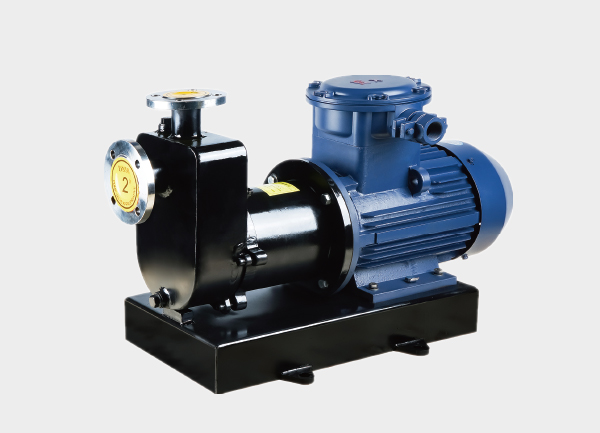
I. Working Principle and Core Structural Design
1. Magnetic Coupling System
The magnetic drive system consists of an outer magnetic rotor (driven by the motor) and an inner magnetic rotor (connected to the impeller). Both are made from high-performance rare-earth permanent magnets such as NdFeB (Neodymium Iron Boron) or SmCo (Samarium Cobalt).
SmCo magnets can withstand temperatures up to 350°C, maintaining stable magnetic torque transmission.
With optimized magnetic circuit design, torque transmission efficiency exceeds 98%.
The containment shell (isolation sleeve) between the rotors is typically made of Hastelloy alloy or carbon-fiber-reinforced PEEK, formed by seamless spinning. It can endure pressures above 10 MPa while reducing eddy current loss to just one-third of traditional metallic sleeves.
2. High-Pressure Pump Casing
The pump casing is precision cast from high-strength alloy steel or duplex stainless steel and undergoes CNC machining followed by 1.5× working pressure hydrostatic testing (minimum 0.4 MPa, 3 minutes, zero leakage).
For instance, the Qiaoxu Supercritical CO₂ Extraction Pump withstands 45 MPa and features a dual-layer welded casing with a ceramic-coated surface for enhanced durability.
3. Bearing and Lubrication System
Standard bearings are made of silicon carbide (SiC) ceramics, offering:
Hardness up to HV2800,
Service life over 3 years under high pressure,
Temperature resistance up to 500°C.
Graphite bearings, featuring self-lubricating properties, can tolerate short dry runs (≤2 minutes) but have a shorter lifespan (≈1 year).
Because the pump relies on the pumped medium for lubrication, any solids can severely impact durability—e.g., fluid containing 0.1% of 100-mesh quartz sand can reduce bearing life by over 90%. Maintaining fluid cleanliness is therefore essential.
II. Key Technical Features and Advantages
1. Zero-Leakage Safety Assurance
The fully sealed magnetic coupling structure achieves a leakage rate of <1×10⁻⁹ Pa·m³/s, meeting nuclear-grade safety standards.
For example, in third-generation nuclear power plants, all-welded titanium magnetic pumps operate with a radiation leakage rate <1×10⁻⁷ mbar·L/s for reactor coolant transfer.
2. Extreme Condition Adaptability
High Pressure: Design pressure up to 40 MPa; with multi-stage impellers, head exceeds 1000 m.
High Temperature: SmCo magnets and cooling jackets allow operation up to 350 °C, ideal for geothermal brine (250 °C, 12 MPa) applications.
Strong Corrosion: PTFE-lined pumps can handle 98% concentrated sulfuric acid, while Hastelloy C-276 resists chloride corrosion 50× better than standard stainless steel.
3. High Efficiency and Low Maintenance
Magnetic drive eliminates mechanical friction losses. Combined with CFD-optimized impeller design, efficiency improves by 15–20% over conventional pumps.
With 90% fewer wearing parts, the maintenance cycle is tripled.
In one petrochemical plant, switching to magnetic pumps for ethylene transfer reduced annual maintenance costs by 60%.
4. Environmental Compliance and Compatibility
Corrosion-resistant materials (e.g., ceramic coatings) make the pump ideal for strong acid/alkali media.
In chemical wastewater treatment, leakage risk is 90% lower than traditional pumps.
Additionally, noise levels below 75 dB meet industrial noise reduction standards.
III. Typical Applications and Case Studies
1. Chemical and Petrochemical Industries
Corrosive Media: PTFE magnetic pumps handle >60% hydrofluoric acid, lasting 5+ years—three times longer than mechanical seal pumps.
High-Pressure Reactors: In polymerization systems transferring polyethylene slurry (15 MPa), variable-frequency control maintains ±2% flow accuracy.
2. Energy and Environmental Engineering
Nuclear Power: Nuclear-grade magnetic pumps used in spent fuel processing systems achieve leakage rates <1×10⁻⁷ mbar·L/s, compliant with ASME B31.1.
Geothermal Energy: High-temperature magnetic pumps operating in 250 °C sulfur-rich geothermal water last 3× longer than traditional pumps, improving power generation efficiency by 12%.
3. Precision Manufacturing
Semiconductors: Magnetic pumps maintain ultrapure water particle size <0.1 µm, supporting 12-inch wafer fabs.
Biopharmaceuticals: Sanitary magnetic pumps (surface roughness Ra ≤ 0.8 µm) transfer vaccine culture media with 40% lower shear, preserving biological activity.
IV. Technical Limitations and Maintenance Guidelines
1. Performance Boundaries
Speed Limitations: Magnetic coupling’s synchronous nature limits maximum rotational speed; hybrid drive designs are required for high-power systems.
Higher Initial Cost: Due to rare-earth magnets and ceramic components, initial investment is 30–50% higher than conventional pumps, but lifecycle cost decreases by over 20%.
2. Maintenance Essentials
Fluid Cleanliness: Flush with clean water after transferring crystallizing fluids (≈1 minute) to prevent bearing wear.
Temperature Monitoring: Use PT100 sensors to monitor magnetic coupling heat rise; if NdFeB exceeds 120 °C, trigger alarm and shutdown.
Dry Run Protection: Avoid running with closed discharge valve beyond 2 minutes.
Regular Inspection:
Quarterly check magnet field strength; replace if demagnetization >10%.
Annually inspect containment shell with ultrasonic gauge; replace if wall thinning >20%.
V. Design Verification and Quality Control
1. Rigorous Testing Procedures
Pressure Test: Hydrostatic test at 1.5× working pressure, 30 minutes, zero leakage.
Magnetic Torque Test: Transmission efficiency loss ≤ 5%, magnetic flux density ≥ 0.5 T.
Life Test: Continuous operation for 2000 hours with ≤ 0.05 mm bearing wear and < 5% magnet degradation.
2. Material and Process Innovations
3D Printing: Laser Selective Melting (SLM) enables complex impeller geometries, improving hydraulic efficiency by 8% and cutting development time by 30%.
Surface Treatment: Impellers coated with Atmospheric Plasma Sprayed (APS) ceramic layers offer 10× higher wear resistance than standard stainless steel.
Conclusion
High-pressure magnetic drive pumps combine sealless magnetic transmission, corrosion resistance, and extreme pressure tolerance to deliver unmatched performance in demanding industrial environments. Their zero-leakage operation, extended service life, and reduced maintenance make them the preferred solution for modern chemical, energy, and precision manufacturing systems pursuing both safety and sustainability.



